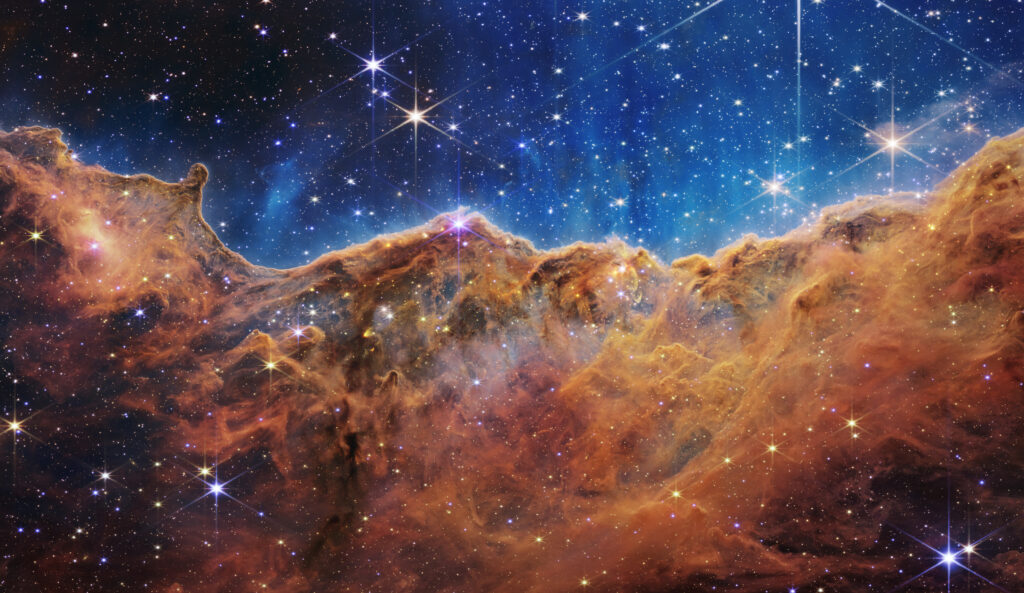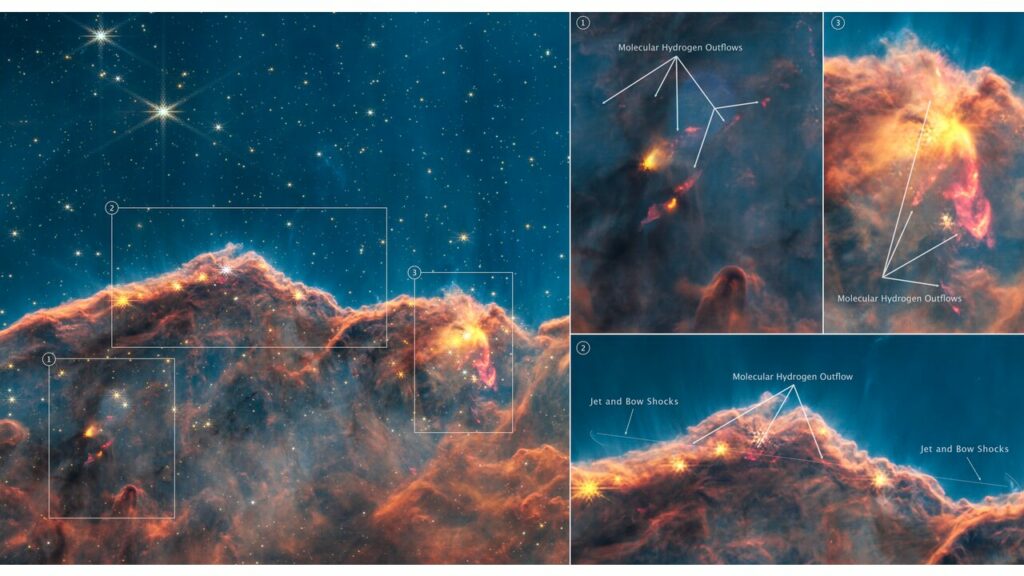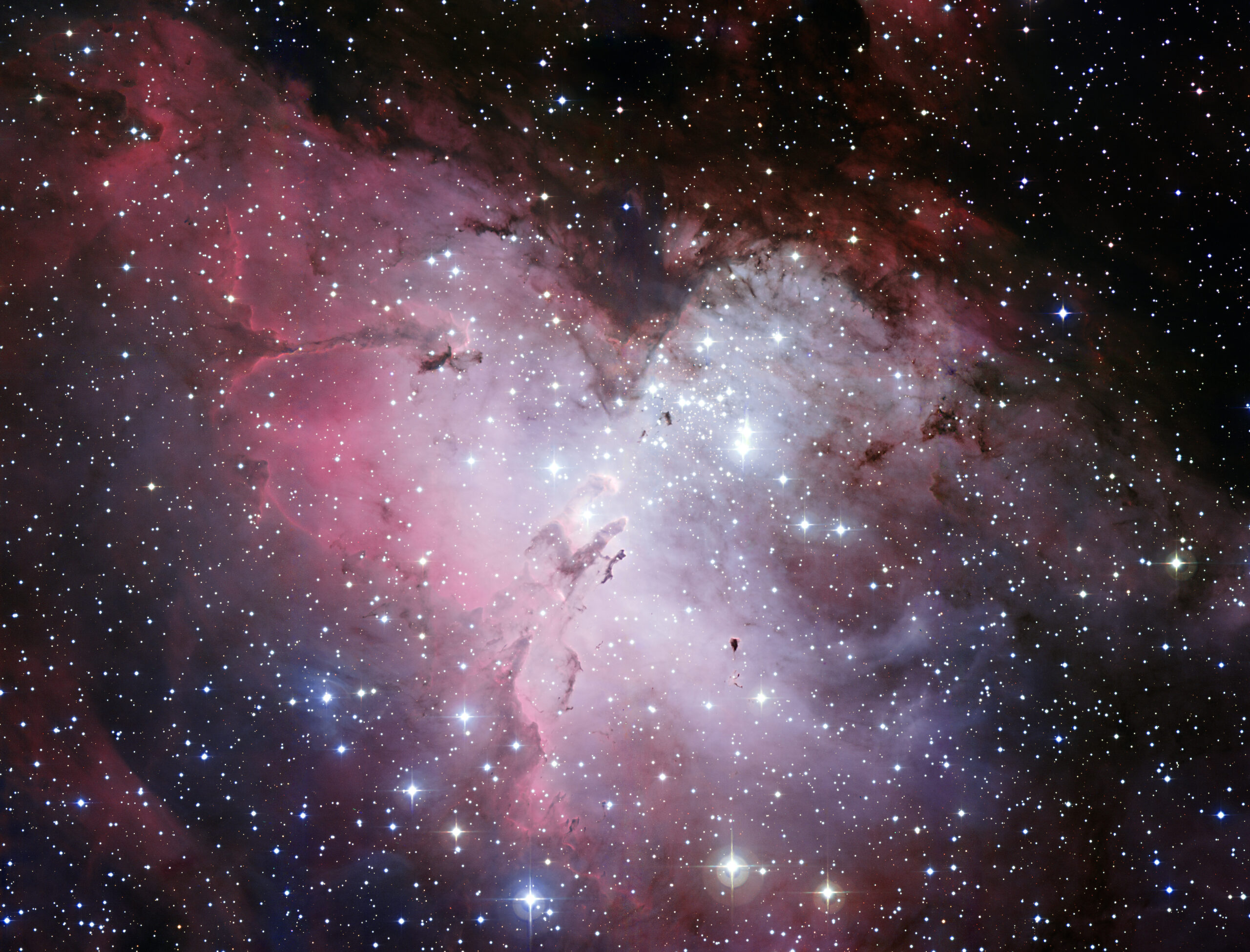Solving Star Formation Mysteries Affirms Big Bang Creation
Did God use natural forces and processes to form the universe’s first stars? Recent images from the James Webb Space Telescope and infrared observations from the SOFIA telescope help answer this question while addressing a challenge from critics of big bang creation.
Doubts about Ongoing Star Formation
Genesis 1:16 states that God “made the stars.” Many Bible readers, especially young-earth creationists, interpret this passage as implying that God supernaturally, instantly, and simultaneously created all, or nearly all, the stars in the universe during creation day 4. Consequently, they assert and teach that astronomers are mistaken in their claims about observing ongoing star formation.
Brian Thomas, staff physicist and science writer at the Institute for Creation Research (ICR), has written, “Based on this [‘God made the stars all on one day’], one would not expect to find stars forming today.”1 Danny Faulkner, staff astronomer at Answers in Genesis, states, “The Bible’s short timespan doesn’t allow time for stars to form out of condensed gas clouds. . . . Furthermore, the Bible does not describe the origin of stars, sun, and the Earth in the same order as the secular model. Genesis 1 explains that the Earth was made three days before the sun and stars, while the secular model puts the sun and most stars first.”2
The Bible and Star Formation
Does the Bible really make the definitive statements that Thomas, Faulkner, and other young-earth creationist leaders and authors claim? As I have explained in my book, Navigating Genesis, the answer is no.3
Genesis 1:2 establishes that the frame of reference or point of view for the descriptions of the six creation days is the surface of Earth’s waters (oceans), below Earth’s cloud cover. Genesis 1:2 adds that it was dark everywhere on the surface of Earth’s waters. Referring to the early Earth, Job 38:9 quotes God declaring, “I made the clouds its garment and wrapped it in thick darkness,” where “its” and “it” refers to Earth’s seas (oceans). The words “garment” and “wrapped in thick darkness” imply that there was light beyond Earth’s clouds. In biblical Hebrew there’s no single word for the universe of matter, energy, space, and time, but there is a Hebrew phrase that is consistently translated as “the heavens and the earth.” This phrase appears 13 times in the Old Testament, always referring to the totality of the physical reality of the universe. Therefore, Genesis 1 affirms God’s words in Job 38:9 that there always was light beyond Earth’s atmosphere and clouds.
Genesis 1:14 states, “Let there be lights in the expanse of the sky to separate the day from the night, and let them serve as signs to mark seasons and days and years.” On creation day four, the Sun, Moon, and stars became distinctly visible from Earth’s surface for the first time. This new visibility allowed these lights to “serve as signs to mark seasons and days and years.” For whose benefit? As zoologists recognize, none of the life existing prior to the fourth creation day needed to know where the Sun, Moon, and stars are in the sky. However, all the life described on creation days five and six is sufficiently complex to require awareness, at least on occasion, of the positions of the Sun, Moon, and/or stars. This awareness reveals to them the best times to feed, reproduce, migrate, and/or hibernate.
Genesis 1:16 is a parenthetical note or a brief review: “God made two great lights—the greater light to govern the day and the lesser light to govern the night. He also made the stars.” The Hebrew verb, ’asa, translated “made,” appears in the appropriate form for past completed action. (There are no verb tenses in Hebrew to parallel verb tenses in English. Rather, three Hebrew verb forms are used to denote action already completed, action not yet completed, and commands.) Verse 16 makes no specification as to when in the past the Sun, Moon, and stars were made. However, the wording of verses 17 and 18 provides a hint: “God set them in the expanse of the sky to give light on the earth, to govern the day and the night, and to separate light from darkness.” The similar wording as day one (verses 3–5) is significant. It suggests both when and why God created the heavenly lights.
Meanwhile, the Hebrew verb, haya, translated “let there be” in Genesis 1:14, permits the interpretation that God manufactured the stars through a careful guiding of the natural processes and forces he created. Thus, there is nothing in Genesis 1 or anywhere else in the Bible that precludes stars from forming out of condensed gas clouds. Also, a literal, consistent interpretation of all the Bible’s creation texts establishes that the Genesis creation days must be six consecutive long periods of time. Given such, there’s nothing in the Bible that precludes God from allowing a star to form over millions of years and the stars in the universe to form and burn over billions of years.
Science and Star Formation
ICR’s Thomas has asserted, “Stars could only form in theory through an unlikely nearby star explosion. And then that exploded star would need another earlier nearby star explosion. Clearly, the first star would never have formed. Plus, this process would have littered the universe with debris from countless star explosions. Instead, it is as clean as a whistle, which is a big problem for secular astronomers looking for missing supernova remnants.”3 Faulkner makes a similar point: “A shockwave from a supernova explosion could compress a gas cloud so that it contracted to form new stars. Even if we observed a gas cloud collapsing today, that still doesn’t explain how the original stars formed by natural processes.4
Both Thomas and Faulkner claim that a supernova shock wave is necessary for stars to form by natural processes. Supernova shock waves speed up star formation but they’re not the only natural means by which stars form. Galaxy collisions are an even greater accelerant. Astronomers have observed thousands of starburst galaxies, where the galaxy is dominated by young stars that formed soon after another galaxy collided or merged with the galaxy.
Supernova shock waves and compression from collisions with a nearby galaxy are two ways to initiate the condensation of gas clouds so that the clouds then self-gravitate to form stars. However, they’re not the only ways. For a star to form from an interstellar gas cloud, the gravity that forces part of the gas in the cloud to collapse must be stronger than the radiation forcing that gas to expand. Some outside gravitational fields can cause or disrupt cloud collapse and some can accelerate or disrupt cloud expansion. Astronomers have observed both collapsing and expanding small gas clouds within larger interstellar gas clouds. New stars form in the collapsing small gas clouds.
It’s true that no astronomer has observed the entire process of star formation from start to finish in a single collapsing gas cloud. That process is much longer than the lifespan of any astronomer, typically many millions of years. However, by making observations of thousands of different collapsing gas clouds, astronomers have witnessed all the stages of star formation.
The First Stars
Both Thomas and Faulkner have stated that if stars form through the naturalistic forces and processes that God established, then stars are necessary to form stars. In that context, they claimed that there was no explanation for the first stars. However, as I explained, all that’s needed for a star to form is for a gas cloud to contract sufficiently for the gas to self-gravitate into a star.
In an expanding universe, gas is much more condensed in the early universe than it is in the present universe. In an expanding universe, though, the universe begins with only two elements—hydrogen and helium and just a trace amount of lithium. Molecular hydrogen (H2) is required to generate sufficient local gas cooling for stars to form. However, helium hydride (HeH+) is an essential precursor for the formation of molecular hydrogen.
Helium hydride is impossible to detect in astronomical sources using ground-based telescopes. Only recently—through the use of the SOFIA telescope on board a Boeing 747 jet flying high above the stratosphere—has helium hydride been detected.5 Thus, the processes for initial star formation have been observed.
Supernova Remnants
There’s also no basis either for Thomas’s claim that there are “missing supernova remnants.” Supernova remnants as distinct features can only be detected if the remnant has been expanding for less than about 10,000–20,000 years or if the remnant is in a region of very low stellar density, such as the halo of our galaxy. Therefore, it’s not at all surprising that the number of clearly detected distinct supernova remnants is less than what the big bang and star formation models predict. The truth is that the plane of our galaxy is so littered with the remnants of past supernovae that the remnants have blended together to form a radiation background with the distinct characteristic of ancient supernova remnants.6
Observing the Most Exciting and Ephemeral Part of Star Formation
Nearly all phases of star formation have been well confirmed by thousands of telescope images. There is one phase, however, where, until now, no detailed images existed. One of the missions of the James Webb Space Telescope (JWST) was to fill this gap. Astoundingly, the JWST has achieved this mission in the first half year of its mission.
A team of six astronomers led by Megan Reiter did what they called a “deep dive” analysis of one of the first five astronomical images taken by the JWST of the “cosmic cliffs” of the Carina Nebula (NGC 3324).7 Figure 1 shows the original JWST image of the Carina Nebula’s cosmic cliffs.

Shown here is the 14.4 megapixel image. The original image is 123 megapixels. Credit: NASA/ESA/CSA
This image is a composite of images taken through different infrared filters by the JWST. Reiter’s team analyzed images taken through three different filters at 4.7, 4.44, and 1.87 microns wavelengths. For comparison, the visible part of the light spectrum is 0.75–9.38 microns. Each of these filters penetrates the thick dust in the Carina Nebula to different degrees and in different ways. Images through these filters unveiled details in the Carina Nebula that previously had been hidden by the Carina Nebula’s dust clouds. Reiter and her colleagues discovered 24 energetic jets and outflows streaming out from protostars, stellar-like objects that are not yet fully formed stars. Figure 2 shows the jets, outflows, and protostars discovered by Reiter’s team.

Credit: NASA/ESA/CSA/Reiter et al.
Some of the jets and outflows are relatively small. Others extend a few light-years out from the emitting protostars. Reiter’s team uncovered the most active and rapid phase of star formation. The protostars they studied are aggressively accreting material from the gas and dust that surround them. Most of these protostars, at the same time, are ejecting (from their polar regions) a fraction of the material they are accreting back out into the Carina Nebula’s interstellar medium.
The aggressive accretion of gas and dust by the protostars and the subsequent jets and outflows leave no doubt that the protostars are on their way to becoming fully fledged stars. The most fleeting and difficult-to-detect phase of star formation has now been clearly observed. No longer can young-earth creationists assert that “star formation is an assumption, not an observation.”8
Design Implications
The research conducted by Reiter’s team is just the beginning of the JWST’s mission to reveal a comprehensive and detailed history of how stars and planets form across the entire range of observed star and planet masses. I’m confident in predicting that this mission will provide more evidence for big bang creation. I also expect that it will unveil even more astounding designs of our Sun and its system of planets to make our existence possible than what I was able to describe in Designed to the Core.9 I’ll keep you posted.
Endnotes
- Brian Thomas, “Study: Star Formation Is Virtually Finished,” Acts & Facts: News, Creation Science Update, The Universe Was Created Recently (November 20, 2012).
- Danny Faulkner, “Are Stars Still Forming Today?,” Answers Magazine (January 25, 2015), 48–49.
- Thomas, “Study: Star Formation.”
- Faulkner, “Are Stars Still Forming.”
- Rolf Güsten et al., “Astrophysical Detection of the Helium Hydride Ion HeH+,” Nature 568 (April 17, 2019): 357–359, doi:10.1038/s41586-019-1090-x; Hugh Ross, “Helium Hydride Detection Affirms Big Bang Creation Model,” Today’s New Reason to Believe (April 29, 2019).
- Hugh Ross, A Matter of Days, 2nd ed (Covina, CA: RTB Press, 2016), 215–216..
- Megan Reiter et al., “Deep Diving Off the ‘Cosmic Cliffs’: Previously Hidden Outflows in NGC 3324 Revealed by JWST,” Monthly Notices of the Royal Astronomical Society 517, no. 4 (December 2022): 5382–5405, doi:10.1093/mnras/stac2820.
- Thomas, “Study: Star Formation.”
- Hugh Ross, Designed to the Core (Covina, CA: RTB Press, 2022).





